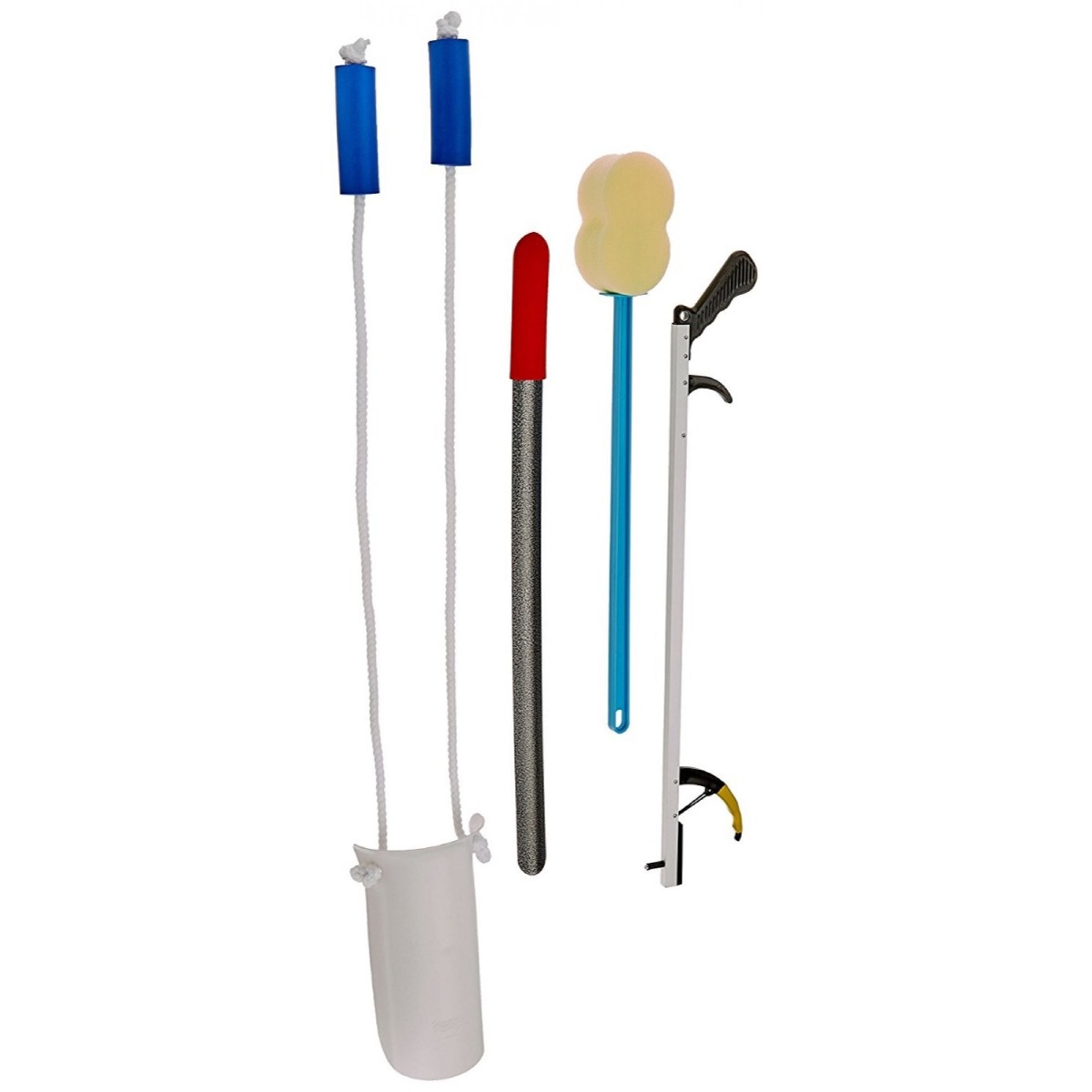When the cartilage and joints of the knee break down, you might need a knee replacement. If you are in too much pain and can no longer do daily activities like climb the stairs, get out of your recliner, or walk to your car, your doctor might recommend a replacement. Common causes of this wear and tear include osteoarthritis, rheumatoid arthritis, deformities, and knee injuries.
Preparing for Surgery
Pre-Surgery Checklist
- Talk to your doctor to go over the procedure and ask any questions you may have.
- Prepare for someone to drive you to and from the hospital.
- Create a bedroom on the first floor if possible. If necessary, this can just be a living space during the day to minimize using the stairs.
- Secure a safety bar in the shower.
- Install a bath bench or shower chair.
- Buy a toilet seat riser (one with handles will give you better leverage).
- Purchase other helpful items like a reacher, dressing stick, and sock aid for help when getting dressed.
- Remove any cords, rugs, or furniture that will block your pathway. Get a stable chair with a firm back and seat.
- Use a footstool to keep your leg elevated.
- Do meal prep ahead of time to save you work post-surgery.
Must-Haves Aids for a Knee Replacement
- Grab Bar: Install in the shower or near the toilet for a sturdy place to hold for support.
- Raised Toilet Seat: This seat makes it easier to sit and rise from the toilet.
- Reacher: Grab items on the floor without bending your knee. The reacher can also be used to pick up items off high shelves.
- Dressing Stick: This stick can hook and pull pants and other clothing up to make getting dressed easier.
- Shoe Horn: A long shoe horn helps you put your shoes without squishing the backs.
- Tylastic Shoelaces: Another great aid for putting on your shoes. Tie these laces once and slide into them every other time.
- Sock Aid: Pulling up socks can be hard when you can’t bend your knee. Place your sock on this aid and use the cord to pull them up.
- Bath Brush: A long brush lets you wash your feet and legs when you can’t bend over.
- Shower Chair: If standing for long periods of time is difficult, you can use this chair to sit and take pressure off your knee.
Many of these items can be purchased together in a Sammons Preston Knee Kit.

During Surgery
You will be given general, regional spinal, or regional epidural anesthesia prior to surgery. If options are available, the doctor will discuss your preferences. The physician will then make a four to ten inch incision in the top of your knee. The length depends on if this is a standard or minimally invasive procedure.
There are four main types of knee replacements that determine what damaged bone and cartilage are removed.
- Total knee replacement: This is most common and replaces the knee joint and the surfaces of the thigh and shin that connect to the knee.
- Partial knee replacement: This surgery is used if only one part of the knee is worn out. The affected joint is replaced and the rest of your tissue and joints are left intact. It is a less common procedure.
- Kneecap replacement: This replaces only the kneecap, but some doctors advise against it because a total replacement has a higher success rate.
- Complex (revision) knee replacement: This procedure is done on people with severe arthritis or if this is someone’s 2nd or 3rd knee replacement.
There are a variety of implants available made of ceramic, metal, or plastic. Your doctor will determine the best choice for you depending on your height, weight, and activity level. Current implants last up to 20 years.
The implant, also know as an orthosis, will then be attached to your existing bone. The surgeon might use bone cement that dries in 15 minutes or porous components might be used so the bone can grow into the orthosis over time. Sometimes these techniques will be combined. Ask your doctor to see which technique he or she plans to use.
The procedure takes about 2 hours to complete. Before closing the incision, the surgeon will test the new joint to make sure it functions correctly. Afterwards, you’ll be moved to a recovery room until you wake up from anesthesia. Then you’ll move to your hospital room.
After Surgery
At the Hospital
Medication will be given to ease your post-surgical pain. You might be given blood thinners and compression stockings to lessen your risk of a blood clot. A continuous passive motion machine (CPM) might be used to extend and flex your knee while lying down or your knee might just be elevated. You’ll be asked to do breathing exercises regularly and begin moving your foot and ankle. A physical therapist will show you how to properly exercise your new knee when you go home or to a rehabilitation center.
At Home
Continue to do your exercises as instructed. The tools you bought prior to surgery will help you with daily activities like dressing, putting on your shoes, and using the bathroom. An ice pack wrap like the Performa ECT Dorsal Knee Wrap can help relieve pain and inflammation. The hospital might provide you with a knee elevator or you may need to buy your own. It’s a good idea to have one post surgery to reduce swelling. The Rolyan Knee Elevator puts your knee in the ideal position while resting. You might have a walker to help you move around at first.
Within 3-6 weeks after surgery, you will be able to resume most daily activities. At this time, some people start driving again if they can bend their knee far enough to sit, have enough control to operate the pedals, and are no longer on narcotic pain medications.
After recovery, low-impact sports like swimming, golfing, and walking can be resumed. High-impact sports like running, skiing, or contact sports should usually be avoided. Talk to your doctor about your limitations after knee replacement surgery.
A knee replacement shouldn’t be scary. After recuperating, you’ll be able to walk and use the stairs with less pain. Until then, use your knee replacement aids to keep your independence during recovery.
References
Mayo Clinic Staff. (2017, November 10). Knee Replacement. Retrieved from https://mayocl.in/2RPckC9
What's Knee Replacement Surgery? (n.d.). Retrieved from https://wb.md/2ULYK4n
Medical Disclaimer: The information provided on this site, including text, graphics, images and other material, are for informational purposes only and are not intended to substitute for professional medical advice, diagnosis or treatment. Always seek the advice of your physician or other healthcare professional with any questions or concerns you may have regarding your condition.








 France
France Australia
Australia



